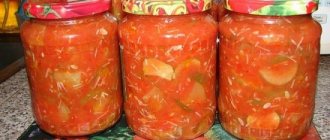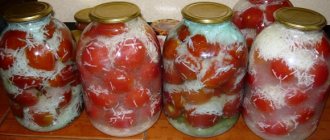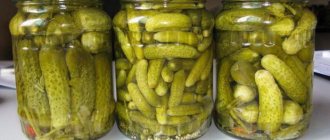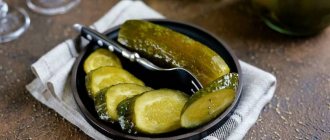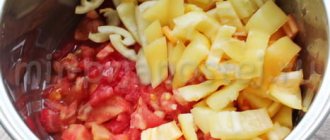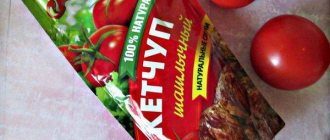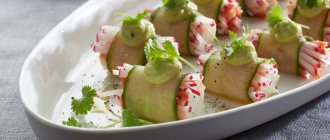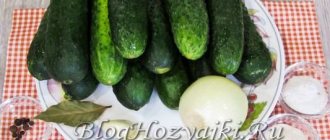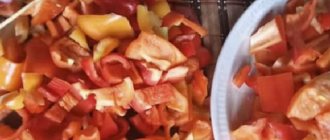The harvesting season is a hot time for any housewife. When harvest time begins and work is in full swing in the kitchen, I really want to do without unnecessary hot processes: boiling, sterilization and pasteurization. This is possible if you pickle cucumbers in a cold way.
Cold pickling of cucumbers is considered the simplest and most convenient way of home canning, allowing you to preserve the beneficial properties of vegetables
Cold salting technologies have come down to us since ancient times. Previously, capacious wooden barrels and tubs were traditionally used for it. Now cucumbers can be pickled in a plastic bucket or in an enamel pan, ceramic or glass container. Many people prefer to cold pickle cucumbers for the winter in jars of a suitable size (liter, three-liter), which are easier to store and more convenient to use.
It has long been customary in Rus' to salt cucumbers with cold water in oak barrels, which added additional flavor and provided an unsurpassed crunch.
All pickling recipe options are based on a minimum set of ingredients: cucumbers, water, spices and herbs. Each of them has its own nuances. Thus, cucumbers , with tubercles and pimples, spiky, and with a fairly thin peel. For uniform salting, their size should be approximately the same. water is needed: ideally, well or spring water; city residents replace it with filtered, cold boiled, thawed water (after freezing), or purchased water. salt is used; using iodized or fine salt (extra salt) is strictly not recommended, as the cucumbers become soft and tasteless. spices to suit their taste, but it is important to consider that tarragon, horseradish, oak leaves are beneficial for crunch, and excess garlic is detrimental.
How to pickle cucumbers without vinegar
Vinegar often gives foods an unpleasant aftertaste, so many housewives prefer to pickle cucumbers without it. But this type of conservation has its own special rules.
Basic Rules
For preparation, choose cucumbers of the correct size; do not take long or too large ones. Fruits no longer than 15 cm are ideal for pickling. The best option is cucumbers from your own garden. However, not everyone has the opportunity to grow vegetables; in this case, cucumbers from the market are also suitable. For storage, choose cucumbers without visible defects, those that have not yet turned yellow or shriveled, and are not frozen.
Attention! It is advisable that all fruits be the same size, otherwise the degree of saltiness will be different.
Choose a jar with a wide neck - this will make it more convenient to place and remove cucumbers.
Why salting under iron lids
Covers for blanks are used in different ways - nylon, glass, plastic, iron. The latter have a number of advantages:
- tightly closed, as airtight as possible;
- keep the product in its original form for several years (if properly stored);
- are inexpensive compared to other options;
- disposable, eliminating the need to process them for reuse.
But iron lids have disadvantages:
- difficulty of seaming;
- Harvesting in large quantities takes a lot of time;
- A special key is required to tighten it.
This type of lid has more advantages, so housewives most often use them for winter preparations.
Preparing for the salting process
It is best to pickle cucumbers on the day they are picked. Young, strong greens must be washed and soaked in cold water for 2-6 hours.
For store-bought cucumbers, as well as varieties with thick skin and sparse large tubercles, it is recommended to trim the bases at the stalks or on both sides
It is not necessary to sterilize jars before cold salting. Wash them well with baking soda and dry. All cooked leaves and herbs are also washed, and if desired, additionally doused with boiling water. Garlic, capsicum, horseradish root are peeled and cut into pieces of the desired size.
Salting stages
Tasty and crispy cucumbers will be obtained if you follow the pickling steps. Otherwise, the product will turn sour in 2-3 weeks, explode in the middle of winter, or develop an unpleasant aftertaste.
Preparing cucumbers
Cucumbers are washed and the tails are cut off. The cut area is at least 0.5 cm. To remove cucurbitacin from the fruits, which gives a specific bitterness, leave them in cold water for 2-3 hours.
Spices
Spices are an important part of the brine. The percentage and composition of the mixture for pickling and marinades is inherited in some families.
Basic spices: fresh garlic, green dill (stems, umbrellas or twigs), pepper pods or peas and salt. Do not add iodized, finely ground salt; coarse rock salt is ideal.
Additional ingredients: oak or birch bark, celery stalks, cherry leaf with the top of a branch, mint, currant leaves, tarragon, thyme and oregano.
Reference. The crunch will be provided by 2-3 amaranth leaves, the specific aroma will be provided by parsley (seeds) and bird cherry buds.
Capacities
Sterility is one of the conditions for long-term storage. The jars are sterilized in a water bath. You will need a separate container for processing the lids. They are washed and scalded to prevent bacteria and mold spores from getting inside the jar. Even the ribs and surfaces of screw threads require attention. The pan for preparing the brine is also treated with detergent.
Laying cucumbers in containers
A “pillow” of greenery is placed at the bottom of the jar. The fruits are layered with garlic cloves, a pot of pepper, dill and selected seasonings. Do not pack the cucumbers too tightly - it is necessary that the brine washes them on all sides and saturates them evenly.
Preparing the brine
The final taste of cucumbers depends on the brine. For cucumbers that will be stored at a temperature of +20...+25°C, and for cucumbers that are allocated a place in the cellar, different brines are prepared.
Features of hot salting
The hot salting method is more reliable, but, according to some housewives, less environmentally friendly. This type of preparation is stored longer, but under the influence of high temperatures, vegetables partially lose their beneficial properties.
The main difference is that the brine used for pouring is hot. For better storage, add vinegar or citric acid. This option for preparing cucumbers involves one more additional step - keeping the containers warm for fermentation. Typically this period is 4-5 days.
The step-by-step process looks like this:
- All ingredients are prepared and placed in jars.
- Pour hot brine and leave to ferment.
- After 4-5 days, drain the brine and remove the cucumbers and herbs from the jar.
- Vegetables are placed in clean containers, and greens are thrown away.
- Bring the brine to a boil, pour into the jars and seal.
Important! Canning in this way allows you to store the preparations at room temperature, but it is better to put them in the cellar or put them in a cool pantry.
How to sterilize lids with rubber bands
Sterilization destroys all dangerous bacteria at temperatures of +100°C and above. There are two ways to carry out this procedure - steam and boiling water. Boil the lids without a rubber band.
Steam sterilization:
- Pour water into the pan until it reaches about halfway.
- The colander is installed so that it does not touch the water.
- After the water boils, place the lids in a colander so that the inside is exposed to the escaping steam.
- Close the container with a lid and leave for 12-15 minutes.
- The caps are ready for use.
Boiling water sterilization:
- Pour water into the container and wait for it to boil.
- The lids are placed in boiling water and closed.
- After boiling again, wait 7-10 minutes.
- The lids are ready to use.
Cold salting
This cucumber recipe is suitable for those who have a cellar or a spacious refrigerator for storing snacks for the winter.
The following composition of products is required:
- 2 kilograms of fresh cucumbers;
- spices to taste: horseradish leaves, garlic, dill umbrellas, hops - suneli;
- 2 liters of plain water;
- 2 tablespoons salt
Recipe for making cucumbers without vinegar:
- Cucumbers need to be soaked for several hours, put in jars, then add spices.
- Then add salt and fill with plain cold water.
- Then cover with a plastic lid and place the jars in a cool place.
- Already, after three weeks, the cucumbers will be ready and you can eat them.
Preservation recipes without vinegar
Vinegar is an optional ingredient in the preparations. It is replaced with currant and cranberry juice or lemon. Thanks to them, the finished product acquires not only a more refined taste, but also an original color.
Cold method: classic recipe
Ingredients for a three-liter jar:
- cucumbers (pre-prepared) – 1.5 kg;
- water (boiled, chilled) – 1.5 l;
- salt – 3 tbsp. l.;
- granulated sugar – 1.5 tsp;
- black pepper (peas) – 7-10 pcs.;
- dill (twig, umbrella, stems) – 4-5 pcs.;
Ingredients for a 1 liter jar:
- prepared fruits – 0.5 kg;
- water – 0.5 l;
- salt – 35 g (1 tbsp.);
- granulated sugar – 0.5 tbsp. l.;
- black pepper – 1-2 pcs.;
- dill, celery stalks, horseradish leaves - 1-2 pcs.
Pre-washed and chopped fruits are placed in jars in layers with herbs and spices. Dense packing will ensure that the final brine is rich - during the pickling process, the cucumbers will produce more juice. Brine is poured after installation.
The jar is placed in a dark place. To prevent the rays from accidentally entering, wrap the container with cloth. At the first stage, store at room temperature. The jars are left for three days, during which time the brine will ferment. Later, the temporary lid is replaced with a permanent one, and the jar is transferred to a cold place.
Important! You need to add water to the jar regularly while the nitrous is forming.
Crispy, with horseradish and garlic
Ingredients for a three-liter jar:
- peeled fruits – 2 kg;
- dill, parsley, horseradish – 3-5 stems;
- peeled garlic – 0.5 heads;
- salt – 35 g;
Ingredients for a 1 liter jar:
- washed and trimmed fruits – 0.8 kg;
- dill, celery, horseradish - 1 pc.;
- crushed garlic – 1-2 cloves;
- salt – 0.5 tbsp. l.
Cucumbers are washed in 2-3 changes of water or under the tap. The tails are cut to a thickness of 0.5 cm. Horseradish, dill, and celery are washed and cut. There is no need to peel the garlic, just crush it with a knife. Fruits and spices alternate in the jar. The first to be placed on the bottom is a “pillow” of greenery.
The brine is prepared in a separate clean container and cooled to +20°C. The brine is poured into a jar, closed with a temporary nylon lid and the container is shaken. If the cucumbers are compacted, pour in the remaining brine. Can be served after 5 hours.
With berry leaves
Ingredients for a three-liter jar:
- processed fruits – 2 kg;
- gooseberries - 0.5 tbsp.;
- garlic – 1 head;
- cherry and currant leaves - 6 and 3 pcs.;
- horseradish, dill - to taste;
- pepper, cloves – 9 pcs.;
- horseradish root – 1 pc.;
- water – 2 l;
- salt – 150 g;
- granulated sugar – 6 tbsp. l.
Ingredients for a 1 liter jar:
- peeled, trimmed fruits – 1 kg;
- gooseberries – 100 g;
- garlic – 4 cloves;
- cherry, currant, apple leaf - to taste;
- horseradish (root) – 3-5 cm;
- dill - 3-4 stems;
- pepper and cloves - 4 peas each;
- water – 1 l;
- salt – 2 tbsp. l.;
- sugar – 3 tbsp. l.
The horseradish is peeled, washed and cut into small longitudinal bars. The container is sterilized, and a “cushion” of greenery is placed on the bottom. The cucumbers are compacted on top, avoiding damage to the peel - this will deprive them of their crunch.
Spices, salt and sugar are dissolved in boiling water. The workpiece is poured with boiling water and left for 1-2 hours. The jars are rolled up and left upside down for 2-3 days. To ensure that the workpieces release heat more slowly, they are covered with a blanket. This will also prevent exposure to sunlight. Before long-term storage, the jars are shaken and turned over to their normal position. On the fourth day the product is ready, but can be stored until spring.
Pickled cucumbers with mustard without additional sterilization
A good cook is always willing to try something new. I also love experiments, and I also like when the product looks aesthetically pleasing. That's why cucumbers with mustard are one of my favorite recipes. The powder allows you to preserve the pleasant color of vegetables, and also acts as an additional guarantee that fermentation processes will not turn into souring of the preparations.
The preparation of the appetizer is no more difficult than the previous options. True, the filling of the jar is varied, thanks to which an unusually rich aroma of the dish is achieved.
For the convenience of calculations, we will assume that we need to fill two-liter jars. For this volume you will need:
- one kilogram of cucumbers;
- one liter of water,
- table salt – 2 level tablespoons;
- mustard powder - one tablespoon,
- garlic – 2-3 cloves;
- currant, laurel and cherry leaves;
- dill umbrella or seeds (½ teaspoon);
- horseradish roots and leaves;
- dry clove buds - 3-4 pieces,
- allspice peas.
If possible, you can add oak leaves; they make the cucumbers especially crunchy and dense. First, thoroughly rinse the jars with soda and hot water. Thanks to the use of mustard and boiled water in the recipe, additional sterilization of the container is not required. Boil and cool water, add salt to it.
We wash the greens well and put half of them on the bottom.
In the second layer we place peeled garlic and a small horseradish root, cut into large slices. We place the vegetables, first the largest ones vertically, then add smaller ones, filling the entire space.
Place the remaining greens on top. Fill with brine and add mustard powder.
Screw on the lid, previously scalded with boiling water. Such preparations are stored in the cold. A cellar or regular refrigerator will do. You can taste the snack within a month, and the shelf life is one year.
Important Tips
There are many recipes, but there are also general requirements for preparations:
- Jars and lids must be sterilized and handled only with clean hands.
- The jar may burst due to temperature changes and souring. Precautions must be taken.
- A prescription with aspirin is not suitable for people who have gastrointestinal diseases.
- Do not use such preparations if you are hypersensitive to salty and spicy foods.
Pros and cons of canning in 1 liter jars
It is convenient to seal cucumbers in liter jars if there are 2 - 3 eaters in the family. In winter, eat open vegetables a day in advance.
It makes no sense to pickle cucumbers in 3-liter jars: opened ones are stored in the refrigerator for less than a week. The fruits begin to sour and mold if no one wants cucumbers anymore. A couple of fruits often turn sour and disappear.
Pickles without vinegar in liter jars last longer.
Not forgetting the recipe for 1 liter, you can easily calculate the required number of products for both 2 and 3 liter vessels.
Disadvantages:
Naturally, there is a lot of fuss. More containers need to be screwed in.
Selection and preparation of ingredients
It is preferable to take cucumbers for harvesting from your own plot. If there is none, then you can negotiate with those gardeners who grow this vegetable. At the market, you should buy any crop only from direct sellers, and not from resellers. Cucumbers for preservation should be the same size, dark and without yellowness on the light part. Careful selection of all ingredients is important not only for beauty when placing them in a jar - healthy fruits are the basis for high-quality preservation with a long shelf life.
Did you know? Pickled cucumbers retain fluid in the body, so those who watch their figure are shocked by the morning readings of the scales. There is no need to worry - this is not excess weight at all, but fluid that will leave the body within a few hours.
Options for “lazy” sterilization
- In the microwave. To sterilize jars in the microwave, you need to fill each jar a little with water, otherwise they will simply crack. If the jar is tall, you can put it on its side, but you must add water. Set the power to 800-900 watts and turn on for 3 minutes. Sterilized jars are ready!
- Dishwasher safe. To do this, you need to put the jars washed with soda inside and set them to maximum temperature - no detergent will be useful.
- In potassium permanganate. This method is suitable if it is completely inconvenient to boil water, install complex structures, or simply do not have enough time. After washing with soda, each jar must be rinsed in a bright pink solution of potassium permanganate.
How to properly store workpieces
To ensure that pickled cucumbers remain tasty, juicy and crunchy throughout the winter, proper storage is very important. Its conditions depend on the method of preparing winter preparations, as well as sterilization of the containers used.
Storage conditions
Pickled cucumbers are stored in a cool, dark place, away from direct sunlight . This could be a basement, cellar, balcony, cool pantry. Optimum temperature up to +5°C.
Shelf life
If all storage rules are followed, the shelf life of pickled cucumbers is 12-24 months . Store an open jar only in the refrigerator, but not longer than 6-7 days.
With red currants
If you prepare cucumbers without adding vinegar according to this recipe, then add currants.
As a result, I get a marinade without vinegar, that is, without acids of synthetic origin. The snack has a special and unusual taste.
Required ingredients for the recipe:
- 2 kilograms of cucumbers;
- 2 cups red currants;
- spices to taste (currant leaves, cherries, garlic, peppercorns);
- 2 liters of water;
- 2 tablespoons sugar;
- 2 tablespoons salt.
Recipe:
- Prepare sterile jars in advance.
- Place cucumbers and spices, including currants, and pour boiling water for 15 minutes.
- Then drain the water, add sugar and salt. Boil the brine and pour into jars.
- Seal and wrap until the jars have cooled completely.
Features of storing workpieces
It is not advisable to store preserved food for years, since next season the crop will need to be processed again, and both containers and space will be needed for it. Fresh and tasty pickles are best consumed in the first winter after harvesting. This is especially true for cold-cooked pickles. Jars should be stored in a cool or cold place where there is no or minimal access to light. Pickling cucumbers can be done without vinegar. Many fruits, vegetables and substances have preservative properties to one degree or another, which can be enhanced with additional ingredients in the recipe and produce excellent crispy cucumbers.
Options for pickling cucumbers for the winter without vinegar
Experienced housewives can recommend many ways to prepare cucumbers without acetic acid. For example, for those who like a certain sour taste, there is a method of pickling with citric acid or aspirin. Fans of spicy foods can make cucumbers with horseradish, garlic or hot chili peppers, and fans of new spicy flavors can use cloves, bay leaves, allspice, mint, marjoram, oregano, basil, tarragon and so on in their preparations. Also, the palette of flavors of pickled cucumbers is growing due to the main difference in the methods of pickling cucumbers: hot or cold. For clarity, let’s look at several different recipes for pickling cucumbers for the winter without vinegar.
With aspirin
The best option is to pickle cucumbers with aspirin.
Aspirin is the same acid, similar to vinegar. If you don’t like sweet cucumbers, you can add less sugar.
List of ingredients for the recipe:
- 2 kilograms of cucumbers;
- 3 aspirin tablets;
- 1.5 liters of drinking water;
- Spices, herbs to taste;
- 6 tablespoons sugar;
Recipe:
- Jars must be sterile. Put spices, herbs and cucumbers in them.
- Fill the jar with the contents with boiled water and leave for 30 minutes.
- Then drain the water, boil again and fill the jar again for about 30 minutes.
- Then drain the water again, add sugar and salt, boil it and fill the jars with cucumbers. Aspirin is added last, and the jars must be sealed.
